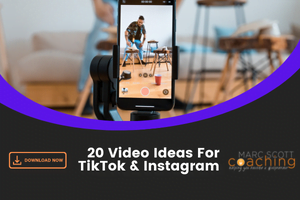The other day I posted a picture on Instagram. I’d taken a screenshot of my intinerary in my Delta app. It showed the number of days until check-in for three upcoming flights.
 In other words, this was not a stunning photograph. No breathtaking sunset. No full moon night sky. No masterful architectural creation. No beautiful people. Just a boring screenshot of something I was really excited about. Getting on an airplane is fun.
In other words, this was not a stunning photograph. No breathtaking sunset. No full moon night sky. No masterful architectural creation. No beautiful people. Just a boring screenshot of something I was really excited about. Getting on an airplane is fun.
A day later, I received a comment on that Instagram post. “Beautiful! I’m a photographer in NYC check out my portfolio.”
If ever there was a failed attempt at marketing, add this one to the list. “Beautiful,” really?
It seems clear to me this photographer has an automated system in place to leave comments on Instagram pictures that are probably connected to a particular hashtag. Either that, or they’re actually wasting their time spamming new posts with a request to visit their portfolio.
Whatever the case, it comes with a couple of valuable marketing lessons you can apply to your voice over business.
4 Lessons Learned From A Failed Attempt At Marketing
1) Limit Automation: Next to recording actual voice over jobs, marketing is the most important aspect of your business. Or, at least, it should be! After all, if you’re not out there spreading the word about your services, there won’t be a lot of booked work. Don’t trust something as important as marketing to a lame, ineffective system.
Bonus Tip: If you’re using Auto DM’s on Twitter (or any other platform), stop right now. Nobody wants an automated, impersonal form message from you for any reason.
2) Know Your Audience: I posted an Instagram photo about check-in dates for upcoming flights. What the crap does that have to do with a photographer in NYC? Why would their portfolio have any relevance to me and what incentive or motivation would I have to visit it? Before you do any marketing, research your audience and tailor relevant, targeted messages designed specifically for them.
Bonus Tip: If you’re not researching your audience ahead of time, you risk wasting a lot of time sending the wrong messages to the wrong people, producing limited ROI.
3) It’s Not About You: “I’m a photographer… check out my portfolio.” Me, me, me. This message was all about them. It demonstrated zero interest in me, my needs, or why their services as a photographer might be relevant to me. When you’re reaching out to voice over leads, your message needs to speak to them, their needs and why your services would be of value to them.
Bonus Tip: Don’t start every sentence with, “I.”
4) Stop Using Form Letters: Do you know where generic emails and form letters go? Into the spam or trash folder. Do you know what happens to those auto DM’s? Delete! If you want to be more effective in your marketing, start being more of a person and less of a robot. If there’s one thing I learned from my early marketing efforts for my voice over business, it’s that generic mass messages produce extremely limited results.
Bonus Tip: Relationship is a big part of the marketing equation. To build relationship, you need to personalize.
How This Example Could’ve Been More Effective
With the above four tips in mind, let’s consider how this photographer could’ve left a more personalized comment that would be much more likely to produce the desired result… to get me to click-through to their profile.
“Hey, Marc. Looks like you’ll be in NYC in a few days. If you need a photographer while you’re in the city, say the word! You can click the link in my bio to check out my portfolio. Have a safe flight and enjoy your trip.”
A couple quick, personalized sentences that would’ve taken just a few extra seconds to type. But they would’ve made all the difference in the world.
By that comment, I would clearly see the message is neither automated, nor a generic response. It’s personalized. It shows they’ve actually looked at the picture I posted. It takes an interest in me and isn’t all about them.
Marketing takes time and effort. It’s easy and tempting to look for ways to automate as much of the process as possible. From scheduling tweets to sending generic form letters. The problem is, the methods aren’t going to be nearly as effective as taking a little time, doing a little research, and adding a personal touch to each communication.






